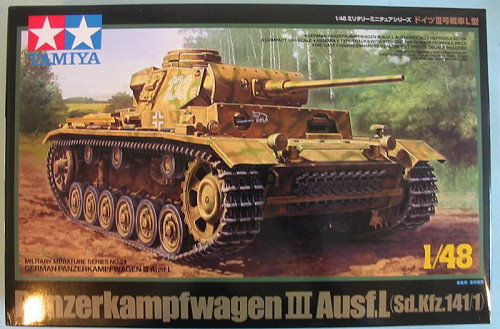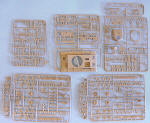
| KIT: | Tamiya 1/48 Panzer III ausf L |
| KIT #: | ? |
| PRICE: | ¥1700 from www.hlj.com |
| DECALS: | Three options |
| REVIEWER: | Tom Cleaver |
| NOTES: |

| HISTORY |
The Panzerkampfwagen III, which was known more commonly as the Panzer III, was developed during the 1930s and used extensively in World War II. It was originally designed to fight other armored fighting vehicles, fighting beside the infantry-support Pzkw IV. By 1942, it was largely obsolete in this role and was replaced by the up-gunned Panzer IV, though some would continue to be used for infantry support until late in the war.
On January 11, 1934, the Army Weapons Department drew up plans for what would be the main battle tank of the newly-forming German Panzer divisions, capable of engaging and destroying opposing tank forces. During 1935, Daimler-Benz, Krupp, MAN, and Rheinmetall produced prototypes, which were tested in 1936 and 1937, with the Daimler-Benz design chosen for production. The first Panzer III A rolled out of the factory in May, 1937, and ten were produced in 1937 and a few other small runs in 1938, during which time much effort was expended on standardizing parts between the Krupp Pzkw IV and Daimler-Benz Pzkw III. Mass production of the Pzkw III Ausf F began in 1939.
Being designed to fight other tanks, the original specifications called for a 50mm weapon. Since the standard infantry anti-tank gun was a 37mm weapon, it was initially decided to use that weapon in the interests of supply standardization, though the turret ring was designed so that a larger weapon could be mounted in the future. The Ausf G was upgraded with the heavier 50 mm KwK38 L/42, while the Ausf J to Ausf M were armed with the 50 mm KwK39 L/60 cannon.
The Panzer III saw action against Poland, France, the Soviet Union and in North Africa, and some were still in use in Normandy and Arnhem in 1944. In the early campaigns against Poland and France they outclassed opponents such as the Polish 7TP, French R-35 and H-35 light tanks, and the Somua S-35 cavalry tank. In part this was due to the German use of a 3-man turret crew with the commander responsible for maintaining situational awareness. The Somua was completely outclassed though on paper it seemed the more heavily-armed tank, due to its one-man turret crew.
Serving in North Africa under Rommel, the Panzer III was always good against the British armor it fought, being more maneuverable and faster than the Matilda and better-armed than the Crusader. It was dangerous to American armored units armed with the M3 and M4 tanks, primarily due to the much greater experience of the German crews.
The invasion of the Soviet Union was where the Panzer III met more than a match in the T-34 and KV tanks, which ultimately proved to be superior, though through 1941 German tactical skill, crew training, and the good ergonomics of the Panzer III all contributed to a 6:1 favorable kill ratio for German tanks of all types in 1941. By the opening of Barbarossa, the Pzkw III had been up-gunned with the 50 mm KwK38 L/42, which could penetrate the T-34's side armor up to 600 yards away. By 1942, the Panzer III was replaced in the main battle tank role by the Pzkw IV with the long-barreled 75mmm cannon, and it disappeared from the main line of battle after the appearance of the Panther in 1943.
The Panzer III chassis became the basis for the Sturmgeschutz III assault gun/tank killer, which was the most important German self-propelled gun of the war.
| THE KIT |
 Having long ago read some accounts of the tank vs. tank fighting in North Africa
in 1941-43, I’ve always thought the Pzkw III was an interesting tank - since it
seemed to scare a lot of British tankers.
Having long ago read some accounts of the tank vs. tank fighting in North Africa
in 1941-43, I’ve always thought the Pzkw III was an interesting tank - since it
seemed to scare a lot of British tankers.
This new model in Tamiya’s line of 1/48 small armor shows the increase in detail that has been adopted since the release of the Sturmgeschutz III that Scott reviewed (URL HERE). Like the other recent releases, all the detail parts are separate. The tracks are multi-part like the other kits. Decals are provided for three vehicles: an all-grey Panzer III with the Hermann Goering Division in 1942, a camouflaged tank serving in Russia in 11942, and one serving in Tunisia in early 1943 in desert camo.
As is standard with the Tamiya small armor, the lower hull is diecast metal. Some modelers have expressed a dislike of this multi-media production, since it requires plastic parts to be attached with cyanoacrylate glue, but for my money I like the heft this gives these small models, resulting in their being less likely to get moved around on the shelf and thus unlikely to get broken as easily as some of the other small armor out there.
| CONCLUSIONS |
Overall, I think this is another excellent addition to Tamiya’s small armor and I think it will be rapidly joining my “tank corps.”
Review kit provided by HobbyLink Japan - get yours at “Japanese prices” at www.hlj.com
If you would like your product reviewed fairly and quickly by a site that has over 300,000 visitors a month, please contact me or see other details in the Note to Contributors.